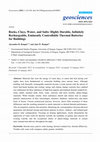Papers by Alexandra Rempel
Four residential sunspaces in Eugene, Oregon were instrumented January-June 2011, measuring indoo... more Four residential sunspaces in Eugene, Oregon were instrumented January-June 2011, measuring indoor air, globe, and surface temperatures, mass surface heat fluxes, relative humidity, and incident solar radiation. Concrete and soil thermal properties were estimated by fitting finite difference heat flow models to field data. En-ergyPlus models using these parameters, site characteristics, and 2011 weather data were then used to quantify heat flow pathways.
Climate-responsive thermal mass design for Pacific Northwest sunspaces
Renewable Energy, 2016

Geosciences, 2013
Materials that store the energy of warm days, to return that heat during cool nights, have been f... more Materials that store the energy of warm days, to return that heat during cool nights, have been fundamental to vernacular building since ancient times. Although building with thermally rechargeable materials became a niche pursuit with the advent of fossil fuel-based heating and cooling, energy and climate change concerns have sparked new enthusiasm for these substances of high heat capacity and moderate thermal conductivity: stone, adobe, rammed earth, brick, water, concrete, and more recently, phase-change materials. While broadly similar, these substances absorb and release heat in unique patterns characteristic of their mineralogies, densities, fluidities, emissivities, and latent heats of fusion. Current architectural practice, however, shows little awareness of these differences and the resulting potential to match materials to desired thermal performance. This investigation explores that potential, illustrating the correspondence between physical parameters and thermal storage-and-release patterns in direct-, indirect-, and isolated-gain passive solar configurations. Focusing on heating applications, results demonstrate the superiority of water walls for daytime warmth, the tunability of granite and concrete for evening warmth, and the exceptional ability of phase-change materials to sustain near-constant heat delivery throughout the night.

Interpretation of passive solar field data with EnergyPlus models: Un-conventional wisdom from four sunspaces in Eugene, Oregon
Building and Environment, 2013
ABSTRACT Passive solar design in the Pacific Northwest relies greatly on traditions established e... more ABSTRACT Passive solar design in the Pacific Northwest relies greatly on traditions established elsewhere, resisting adoption of distinct regional practices despite growing evidence of their value. To promote progress toward climate-responsive design in the cloudy, rainy Cascadian corridor, and to gain insight into often-troubled passive solar performance in the region, energy transfer mechanisms underlying the measured performance of four Oregon sunspaces were investigated using EnergyPlus building models. Air, mass, globe, and soil temperatures, as well as relative humidity and incident solar radiation, were recorded at 10-min intervals in each sunspace from January through June, 2011; models incorporated geometric, material, occupancy, equipment, tree shading, and soil parameters relevant to energy gain and loss. Models were then validated by comparison with air and mass temperature data: all predicted 84–93% of measurement variability. Output showed that over half of all energy entering each sunspace originated as diffuse solar radiation, and that 60–70% of the total was transmitted through shallow-pitched roof glazing, in a pattern contrary to established belief. Similarly, much stored energy was lost through central rather than perimeter floor mass. Orientation exerted a minor effect on performance compared to other factors, particularly tree shading, while solar gain exceeded predictions of long-accepted methods by factors of two to three. Together, these results show that substantial revision of deep-rooted ideas and expectations will be needed to achieve high-performance passive solar heating in the Pacific Northwest.

Uploads
Papers by Alexandra Rempel